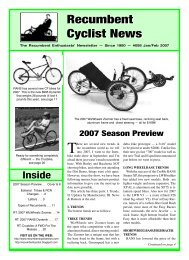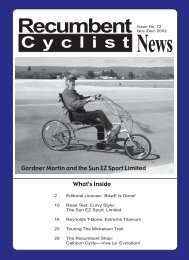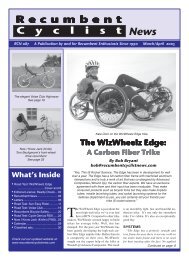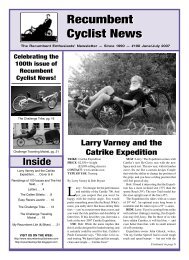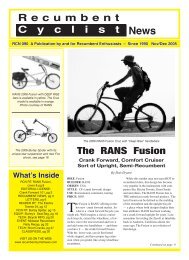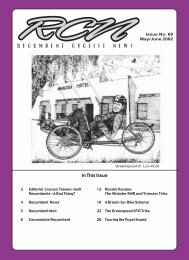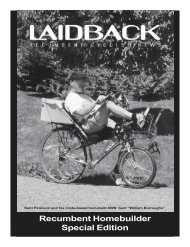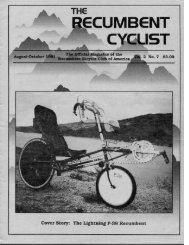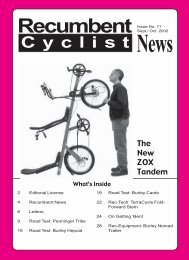What's Inside
What's Inside
What's Inside
Create successful ePaper yourself
Turn your PDF publications into a flip-book with our unique Google optimized e-Paper software.
the KMC chain links (Quick Links) must be<br />
replaced every time you remove the chain and<br />
are not always easy to find (so keep spares). I<br />
wouldn’t go out of my way to replace a new<br />
KMC chain until it was worn out or I was heading<br />
out on a major tour.<br />
When it comes time to replace it, I would opt<br />
for a SRAM (formerly Sachs) chain, which I<br />
consider to be the best bicycle chain available.<br />
SRAM generally shifts better, lasts longer, and<br />
is more trouble-free.<br />
I recently had the opportunity to fit Shimano<br />
chains to a recumbent, and what a painful experience<br />
it was. They use break-off push pins<br />
to splice the links. I ended up using four pins<br />
in one chain, broke a chain tool and was still<br />
concerned about the chain’s strength. Stick with<br />
SRAM and your chain problems should be kept<br />
to a minimum.<br />
SUSPENSION FORKS<br />
The best recumbent suspension is one that is<br />
already integrated into the bike design — such<br />
as those available from HP Velotechnik (Spirit)<br />
and Cannondale. These are well thought-out<br />
systems with the suspension inside the fork, and<br />
are the best I’ve tested. HP Velo is also using a<br />
new fork, the Spinner Grind2, which we haven’t<br />
seen yet. Aftermarket forks are also available<br />
from Meks, Ballistic and White Brothers.<br />
The biggest negative about suspension forks<br />
is the added cost of the fork, and for additional<br />
maintenance costs (rebuilds). Be sure to ask<br />
how often service is required on your fork.<br />
Lighter Weight Forks: Highracers can benefit<br />
from lighter carbon fiber forks. Check out the<br />
bike forums for the latest information. RANS<br />
offers a house-brand aluminum fork upgrade<br />
(and standard on some models). These forks<br />
are lightweight options, and probably not ideal<br />
for fork commuting, touring or heavy riders.<br />
REAR SUSPENSION<br />
A cushy ride can be wonderful and will spoil<br />
you. Suspension is best for urban commuters,<br />
small-wheeled bikes, tourers and those who ride<br />
on rough roads. Rider/load combinations over<br />
200 pounds should look into the availability of<br />
optional heavier springs. Suspension can complicate<br />
fender and rack mounting, adds weight<br />
to the bike, is more expensive, and requires<br />
more maintenance (shock replacement can<br />
cost hundreds of dollars).<br />
The best recumbent suspension designs<br />
have low pivot points for the rear swing arm.<br />
Consider your body weight and if your cargo<br />
weight will also be supported by suspension.<br />
Pogo, or pedal-induced suspension movement<br />
is the sign of a marginal suspension system.<br />
A cheaper alternative is to run fatter<br />
low pressure tires like Schwalbe Big<br />
Apples (see www.balloonbikes.com and<br />
www.schwalbetires.com).<br />
Some frames have more flex to them, and<br />
steel frames are usually more forgiving. Larger<br />
diameter wheels generally ride smoother than<br />
smaller wheels. Steel frames are more forgiving<br />
and have a smoother ride than aluminum, and<br />
titanium will have the smoothest ride (although<br />
some think titanium is too flexible).<br />
HEADSET<br />
One interesting aspect of recumbency is<br />
that not all manufacturers are using threadless<br />
steerer tubes, even on some high-end bikes.<br />
Many companies have unique threadless<br />
clamping systems. Some systems are really<br />
good, and others are just okay. You’ll know<br />
by how difficult installation and adjustments<br />
are. Some threaded headsets can’t be upgraded<br />
without spending big bucks, so ask questions<br />
before you buy.<br />
As far as headsets go, the differences are<br />
the quality of the bearing, cartridge-sealed vs.<br />
caged bearing, ease of adjustment, and quality<br />
of materials. A headset can cost from a few<br />
bucks to over $100. I really like cartridge-sealed<br />
bearing headsets. Two excellent examples are<br />
the Chris King and Ritchey WCS. The Ritchey<br />
WCS lifetime headset has precision machined<br />
aluminum cups, angular cartridge sealed bearings<br />
and is more affordable than a Chris King.<br />
Angletech offers the WCS on several models.<br />
Watch out for non brand name brand mediocre<br />
headsets. Recumbents can put more pressure<br />
on a headset than a road bike, so this isn’t a<br />
place to cheap out. This isn’t something to run<br />
out and replace right away, but if you build up<br />
from a frameset, get a good one.<br />
PEDALS<br />
Most bicycle enthusiasts these days use<br />
clipless pedals. This means that your pedals<br />
have a snow ski-type binding and your shoes<br />
have a cleat that snaps into the binding. Finding<br />
the system that works best for you can be a<br />
time-consuming and expensive task. The most<br />
popular brand of pedals is the Shimano SPD<br />
(Shimano Pedaling Dynamics). SPD pedals<br />
have become the industry standard primarily<br />
because they are easy to use and are relatively<br />
affordable. Some enthusiasts favor BeBops<br />
(www.bebop.com) because they have lots of<br />
float. I’ve had at least one report of reluctant<br />
engage and release in touring conditions with<br />
Bebops. Sadly, these have been discontinued<br />
but may be reintroduced at a later date by a<br />
new maker. Others prefer Crank Brothers Egg<br />
Beaters (www.crankbrothers.com) which have<br />
easy entry/exit (four possible entry positions<br />
compared with two with BeBops or SPDs).<br />
I’ve used Egg Beaters and was unhappy with<br />
the durability. I like Shimano SPD because the<br />
design is time proven.<br />
Some riders experience pain using clipless<br />
pedals (from having your feet in the same position).<br />
Harry Wozniak of Wheel & Sprocket<br />
likened the pain to standing on a ladder for an<br />
extended time. The problem is that clipless<br />
systems were designed for upright bicycles.<br />
- 24 -<br />
Recumbent clipless systems need to have<br />
the cleats mounted further back on the shoe.<br />
Sometimes there isn’t enough room on the<br />
clipless cleat mounting tracks to mount far<br />
enough toward the middle of the shoe. Some<br />
riders modify their shoes with a Dremel tool,<br />
others just ride with incorrect positioning, and<br />
others stop using their clipless pedals in favor<br />
of basic platform pedals.<br />
I use platform pedals and Shimano cycling<br />
shoes for most of my riding. They work especially<br />
well for commuting and on recumbents<br />
with low to medium (seat height) crank positions.<br />
The higher the crank, the more you may<br />
need a foot retention device.<br />
Thanks to the component makers building<br />
parts for Freeride and Downhill style mountain<br />
biking, we now have some really cool platform<br />
pedals to choose from. After breaking a rather<br />
inexpensive oval caged bear trap pedal (the<br />
bike fell over and bent the cage and spindle),<br />
I recently switched to aluminum pinned pedals.<br />
Look for a CNC aluminum or magnesium<br />
body, removable pins, a ChroMoly spindle and<br />
cartridge bearings. The pins act as upside-down<br />
toe clips, though I can vary my foot positions<br />
as I wish. Cool pedals like this can be found<br />
from Sun/Ringle (Zu Zu), Wellgo (Magnesium),<br />
Azonic, Truvativ (Holzfeller) and Syncros<br />
(Mental). Angletech sells a few of these, and<br />
others can be found at www.mtbr.com.<br />
These pinned pedals hold my Shimano shoes<br />
to the pedals and allow me to vary my foot’s<br />
placement on the pedal. I know I’m in a minority<br />
of non-clipless users, but I’m extremely<br />
happy with my retro pedal choices. Racers and<br />
other performance cyclists may need to use clipless,<br />
but commuters, recreational cyclists and<br />
tourists really don’t need to. One last option is<br />
the Power Grip strap. This is a diagonal strap<br />
that crosses the platform pedal. You slip your<br />
foot in at an angle, straighten it, and the strap<br />
holds you in. Ask for these at your local bike<br />
or recumbent shop.<br />
SHOES<br />
If fit is everything, cleat placement is a close<br />
second. On a recumbent the cleats should be<br />
mounted more towards the center of the shoe,<br />
so be careful before you lay down your hardearned<br />
cash.<br />
Angletech sells SIDI shoes which are very<br />
high quality and come in wide sizes. I prefer<br />
the basic Shimano SH-M021G that cost just<br />
over $50. They are relatively flat-soled and<br />
have laces instead of Velcro straps. These are<br />
my favorite bike shoes — ever.<br />
WHEELS<br />
Here are the common recumbent wheel<br />
sizes:<br />
• 16” 305 mm: This smaller diameter and<br />
wider 16” size is found on recreational<br />
CLWB models.



